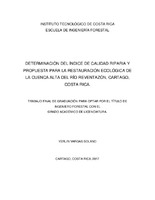Mostrar el registro sencillo del ítem
Determinación del índice de calidad riparia y propuesta para la restauración ecológica de la cuenca alta del río Reventazón, Cartago, Costa Rica
| dc.contributor.author | Vargas-Solano, Yerlin | |
| dc.date.accessioned | 2018-02-08T18:03:21Z | |
| dc.date.available | 2018-02-08T18:03:21Z | |
| dc.date.issued | 2017 | |
| dc.identifier.uri | https://hdl.handle.net/2238/9367 | |
| dc.description | Proyecto de Graduación (Licenciatura en Ingeniería Forestal) Instituto Tecnológico de Costa Rica, Escuela de Ingeniería Forestal, 2017. | es |
| dc.description.abstract | The increase in agricultural activity has caused a constant deterioration of the environment, including the riparian ecosystems. When they are losing their forest cover, also lose their ability to sustain the soil, which causes a significant amount of sediment carried downstream, and also decrease the useful life of hydroelectric dams when they flow into them. For this reason, the objectives of the present study were first to diagnose the current state of the river strip of the upper Reventazón River basin in the northern zone of Cartago, Costa Rica, specifically in the foothills of the Irazú Volcano, to identify those with more significant degradation and promote its ecological restoration. For this, through a supervised classification of a satellite image sites with the lowest vegetation coverage were identified, and visited and evaluated by applying the Riparian Quality Index (IQR) used for determining the level of degradation. Areas to be restored were selected according to the IQR results, and it is developed in Chapter 2 of this work. As a first step for the restoration plan, an interview was applied among farmers who owned lands adjacent to the rivers and streams of interest in the communities studied. The interviews gave essential information about the knowledge of the owners about the topic, the willingness to participate and the project expectations of the farmers. Then, through a bibliographic review a list of species was created and suitable for use in the field. The proposal is composed of three different options, adapted to three conditions of farms, and a bioengineering technique is recommended for shores with very steep slopes and a monitoring program. This work was developed to be applied in the water bodies Chinchilla and Tatiscú rivers and the Rodeo, Arriaz, Coyote and Ortiga streams, however, it can be extrapolated to other areas. | es |
| dc.language.iso | spa | es |
| dc.publisher | Instituto Tecnológico de Costa Rica | es |
| dc.rights | acceso abierto | es |
| dc.rights.uri | https://creativecommons.org/licenses/by-nc-nd/4.0/ | * |
| dc.subject | Clasificación | es |
| dc.subject | Bioingeniería | es |
| dc.subject | Agrícola | es |
| dc.subject | Represas | es |
| dc.subject | Degradación | es |
| dc.subject | Ríos | es |
| dc.subject | Research Subject Categories::FORESTRY, AGRICULTURAL SCIENCES and LANDSCAPE PLANNING::Plant production::Forestry | es |
| dc.title | Determinación del índice de calidad riparia y propuesta para la restauración ecológica de la cuenca alta del río Reventazón, Cartago, Costa Rica | es |
| dc.type | proyecto fin de carrera | es |



